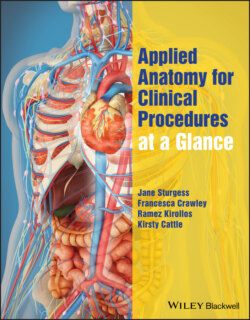Читать книгу Applied Anatomy for Clinical Procedures at a Glance - Jane Sturgess - Страница 10
Оглавление2 Setting up a sterile field and draping the patient
Sherif Kirollos and Ramez Kirollos
Figure 2.1 Equipment.
Figure 2.2 Apply the antiseptic to the operating field in a radial or concentric movement, away from the operating site.
Figure 2.3 Cover the edges of the operating field with sterile drapes, adhering them to sterilised skin.
Figure 2.4 Use of an antiseptic impregnated incise drape reduces surgical site infection.
Figure 2.5 Use sterile drapes to cover an operating trolley on which operating instruments and equipment will be placed.
A sterile field includes the exposed area of the patient to be operated upon or the region through which the trajectory of the procedure crosses. The sterile field also involves the area where the instruments and equipment used for the procedure are placed.
Equipment (Figure 2.1)
Antiseptics (see Chapter 1, Scrubbing up)
Sponge holder forceps
Drapes and plastic adhesive incise drape
Towel holders
Light handle
Masks
Sterile gloves
Gown
Procedure
1 Hair shaving requires a balanced view as shaving the skin area prior to surgery potentially exposes cutaneous and hair follicle bacteria; however, excessive hair in the operating field may hinder sealing of the operating field with adhesive drapes. If no or minimal shaving is adopted, then ensure application of antiseptic (shampoo) to a wider area.
2 Sterile sponge holder forceps with sterile swabs are immersed in an antiseptic solution which is applied to the skin or mucous membrane which is to be sterilised. A prior check regarding allergies to the antiseptic should be completed.
3 Applying the antiseptic solution to the operating field is recommended to be in a radial or concentric movement away from the operative site to avoid contamination from a nonsterile region. This applies particularly in areas proximal to potentially contaminated areas such as the anal orifice or the umbilicus (Figure 2.2).
4 Sterile drapes and towels are used to cover the margins of the exposed and cleaned patient’s skin (Figure 2.3).
5 The skin area to be draped should be cleaned with a generous margin to achieve adequate exposure. This may include adjacent anatomical landmarks used for orientation, for example when operating on the face.
6 The drapes are fixed with an overlying plastic adhesive incise drape to prevent contamination from skin organisms. Antiseptic impregnated incise drapes are recommended to decrease surgical infection (Figure 2.4).
7 The surface of the operating trolley on which the instruments and equipment are to be placed is covered with sterile towels (Figure 2.5). Drapes can also be used to ‘shield’ the sterile area. It is important to maintain the sterility of the surface of the instrument trolleys and the equipment until the end of the procedure.
8 At the end of the surgical procedure, disposable sharp objects and contaminated material should be disposed of in the appropriate containers.
Top tips
The antiseptic has its bactericidal effect by drying. Using a smaller volume of antiseptic and allowing it to dry will have a better sterilising effect than using larger volumes of antiseptic.
